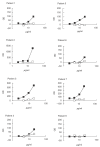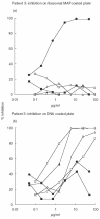Anti-ribosomal antibodies from lupus patients bind DNA
- PMID: 12452847
- PMCID: PMC1906534
- DOI: 10.1046/j.1365-2249.2002.02014.x
Anti-ribosomal antibodies from lupus patients bind DNA
Abstract
Antibodies specific for ribosomal P proteins (anti-P) are a hallmark of systemic lupus as anti-DNA antibodies are. It has been reported that anti-P antibodies are more frequently detected in anti-dsDNA positive sera. The aim of the present study was to verify the binding ability of anti-P antibodies towards polynucleotides and nucleosomes. We purified anti-P antibodies from 8 SLE patients' sera and we analysed them by ELISA on plates coated with DNA or nucleosomes. We performed also inhibition experiments in order to verify the specificity of the binding. All the purified anti-P antibodies bound DNA, but some anti-DNA binding activity remained among the non-anti-P antibodies in the flow through. Only half of the purified antibodies bound to nucleosomes, and anti-nucleosomal activity was demonstrated also in non anti-P antibody fraction. The inhibition experiments performed on two anti-P antibodies pointed out that only the homologous antigen inhibited the binding to either P peptide or DNA coated onto the solid phase. These results show that sera in which the two specificities coexist contain antibodies endowed with a double binding ability for DNA and the P peptide.
Figures




Similar articles
-
Antibodies directed against ribosomal P proteins cross-react with phospholipids.Clin Exp Immunol. 2007 Oct;150(1):140-3. doi: 10.1111/j.1365-2249.2007.03466.x. Epub 2007 Aug 3. Clin Exp Immunol. 2007. PMID: 17680825 Free PMC article.
-
Autoantibodies in systemic lupus erythematosus.Curr Opin Rheumatol. 1998 Sep;10(5):409-16. doi: 10.1097/00002281-199809000-00003. Curr Opin Rheumatol. 1998. PMID: 9746855 Review.
-
The clinical relevance of antibodies to ribosomal-P common epitope in two targeted systemic lupus erythematosus populations: a large cohort of consecutive patients and patients with active central nervous system disease.Ann Rheum Dis. 2000 Feb;59(2):99-104. doi: 10.1136/ard.59.2.99. Ann Rheum Dis. 2000. PMID: 10666163 Free PMC article.
-
The binding of lupus-derived autoantibodies to the C-terminal peptide (83-119) of the major SmD1 autoantigen can be mediated by double-stranded DNA and nucleosomes.Ann Rheum Dis. 2006 Nov;65(11):1525-8. doi: 10.1136/ard.2005.043992. Epub 2006 Mar 15. Ann Rheum Dis. 2006. PMID: 16540553 Free PMC article.
-
[Role of the nucleosome in the physiopathology of systemic lupus erythematosus].Ann Med Interne (Paris). 2003 Feb;154(1):25-32. Ann Med Interne (Paris). 2003. PMID: 12746656 Review. French.
Cited by
-
Are anti-ribosomal P protein antibodies relevant in systemic lupus erythematosus?Clin Rev Allergy Immunol. 2007 Feb;32(1):37-46. doi: 10.1007/BF02686080. Clin Rev Allergy Immunol. 2007. PMID: 17426359 Review.
-
HOT or not: examining the basis of high-occupancy target regions.Nucleic Acids Res. 2019 Jun 20;47(11):5735-5745. doi: 10.1093/nar/gkz460. Nucleic Acids Res. 2019. PMID: 31114922 Free PMC article.
-
International multicenter evaluation of autoantibodies to ribosomal P proteins.Clin Vaccine Immunol. 2006 Jan;13(1):77-83. doi: 10.1128/CVI.13.1.77-83.2006. Clin Vaccine Immunol. 2006. PMID: 16426003 Free PMC article.
-
Antibodies directed against ribosomal P proteins cross-react with phospholipids.Clin Exp Immunol. 2007 Oct;150(1):140-3. doi: 10.1111/j.1365-2249.2007.03466.x. Epub 2007 Aug 3. Clin Exp Immunol. 2007. PMID: 17680825 Free PMC article.
References
-
- Steinberg AD, Klinman DM. Pathogenesis of systemic lupus erythematosus. Rheum Dis North Am. 1988;14:25–41. - PubMed
-
- Bonfa E, Elkon KB. Clinical and serological associations of the antiribosomal P protein antibodies. Arthritis Rheum. 1986;29:981–5. - PubMed
-
- Schneebaum AB, Singleton JD, West SG, Blodjett JK, Allen LG, Cheronis JC, Kotzin BL. Association of psychiatric manifestations with antibodies to ribosomal P proteins in systemic lupus erythematosus. Am J Med. 1991;90:54–62. - PubMed
-
- Teh LS, Lee MK, Wang F, et al. Antiribosomal P protein antibodies in different populations of patients with systemic lupus erythematosus. Br J Rheumathol. 1993;32:663–5. - PubMed
MeSH terms
Substances
LinkOut - more resources
Full Text Sources
Medical

